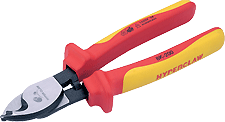HF Antenna Trimming Chart
Serge Y. Stroobandt, ON4AA
Copyright 2019, licensed under Creative Commons BY-NC-SA
Introduction
Trimming an HF antenna may seem a daunting task. There always remains that fear of cutting too much wire off the antenna. In a bid to do away with this common fear, Jim Thompson, W4THU of Carolina Windom® fame, published a very handy HF antenna trimming chart in imperial measuring units. Meanwhile, the rest of the world moved on from using “feet and thumbs” to the more rational Système International (SI). Hence, I took the liberty to convert and rationalise Jim’s trimming chart to metre, centimetre and millimetre units.
Manual
 cable cutter
cable cutter- This chart serves as an aid in trimming the length of HF antennas. The chart estimates, over the length of an approximate quarter wavelength, the required change in length to shift the fundamental antenna resonance by a specific amount of kHz.
Always start out with an antenna that is too long, i.e. resonant below the desired resonant frequency. Cutting wire is easier/cheaper than adding!
- Dimensions are for each leg of a half wave dipole.
- For quarter wave antennas: apply the change in length directly from this chart.
- For full wavelength (loop) antennas: multiply the chart dimension by four (4×) and change the overall length of the antenna by that amount.
The provided trimming lengths are estimates. Many environmental factors (such as ground, height above ground, nearby objects, wire diameter and wire insulation) will affect the trim length.
Trimming Chart
| to shift resonance by … on … trim … per \(\frac{\lambda}{4}\) |
80/75 m | 40 m | 20 m | 15 m | 10 m |
|---|---|---|---|---|---|
| + 500 kHz | - 2.5 m | - 65 cm | - 17.5 cm | - 7.5 cm | - 35 mm |
| + 400 kHz | - 2.0 m | - 52 cm | - 14 cm | - 6 cm | - 32 mm |
| + 300 kHz | - 1.5 m | - 39 cm | - 10.5 cm | - 4.5 cm | - 25 mm |
| + 200 kHz | - 1.0 m | - 26 cm | - 7 cm | - 3 cm | - 16 mm |
| + 100 kHz | - 0.5 m | - 13 cm | - 3.5 cm | - 1.5 cm | - 8 mm |
| + 10 kHz | - 5 cm | - 13 mm | - 3.5 mm | - 1.5 mm | - 0.8 mm |
| | |||||
| - 10 kHz | + 5 cm | + 13 mm | + 3.5 mm | + 1.5 mm | + 0.8 mm |
| - 100 kHz | + 0.5 m | + 13 cm | + 3.5 cm | + 1.5 cm | + 8 mm |
| - 200 kHz | + 1.0 m | + 26 cm | + 7 cm | + 3 cm | + 16 mm |
| - 300 kHz | + 1.5 m | + 39 cm | + 10.5 cm | + 4.5 cm | + 25 mm |
| - 400 kHz | + 2.0 m | + 52 cm | + 14 cm | + 6 cm | + 32 mm |
| - 500 kHz | + 2.5 m | + 65 cm | + 17.5 cm | + 7.5 cm | + 35 mm |
Using a vector network analyser
 miniVNA PRO
miniVNA PRO- Lucky you! All what needs to done, is preparing an open (i.e. nothing), a short and a 50 Ω resistive load that can connect to the terminals of the sheath current choke. If your choke has wire terminals, the 50 Ω calibration load may be constructed out of two high-precision low-inductive 100 Ω resistors. Connect the sheath current choke to a long coax cable and connect the arrangement to the VNA. Hit the calibration button and you are ready to start trimming the antenna at its definitive height.
Beware! There are little black boxes on the market, pretending to be VNAs. However, many of these little boxes do not offer the possibility to calibrate with a 50 Ω load, a short and an open. If it does not calibrate, is not a vector network analyser! Do not spend any money on this.
Using a noise bridge or SWR analyser
 R–X noise bridge
R–X noise bridge- The antenna, mounted at its definitive height, is connected with an R–X noise bridge or SWR analyser over a test coax which needs to be of a specific length. This specific length of coax includes the length of the sheath current choke at the end of the cable which is connected to the antenna. The test coax with the sheath current choke must have an electrical length which is an integer multiple \(n\) of 180°. A transmission line with such a harmonic length has the property of the load impedance repeating itself every half wavelength along the line. This occurs irrespective of the characteristic impedance of the line. The physical length \(\ell\) of the test coax is determined using the following formula which takes into account the velocity factor \(v_f\) of the specific coax type:
\[\ell=n\cdot\frac{\lambda}{2}=n\cdot v_f \cdot \frac{c_0}{2\cdot f}\]
\(n\): an integer number
\(v_f\): the velocity factor of the coax cable (0.66 in the case of a solid PE dielectric)
\(c_0\): the speed of light in vacuum, i.e. 299 792 458 m/s
\(f\): the desired resonance frequency in Hz
 MFJ-259B
MFJ-259B- If the additional electrical length of the sheath current choke is not taken into account, a bit of trimming of the test coax will be required. In order to do so, short circuit the sheath current choke with a short piece of thick wire over its open terminals. Then connect the sheath current choke to one end of the test coax, and the other end to the noise bridge or SWR analyser. Keep trimming the coax shorter until you find an (almost) zero impedance at the desired resonance frequency. Trimming harmonic coax lengths works better with shorting the sheath current choke, than leaving it open. This is because noise bridges and SWR analysers are not good at measuring high impedances. (My MFJ-259B will not measure impedances above 120 Ω!)

This work is licensed under a Creative Commons Attribution‑NonCommercial‑ShareAlike 4.0 International License.
Other licensing available on request.

Unless otherwise stated, all originally authored software on this site is licensed under the terms of GNU GPL version 3.
This static web site has no backend database.
Hence, no personal data is collected and GDPR compliance is met.
Moreover, this domain does not set any first party cookies.
All Google ads shown on this web site are, irrespective of your location,
restricted in data processing to meet compliance with the CCPA and GDPR.
However, Google AdSense may set third party cookies for traffic analysis and
use JavaScript to obtain a unique set of browser data.
Your browser can be configured to block third party cookies.
Furthermore, installing an ad blocker like EFF's Privacy Badger
will block the JavaScript of ads.
Google's ad policies can be found here.
transcoded by
 .
.


